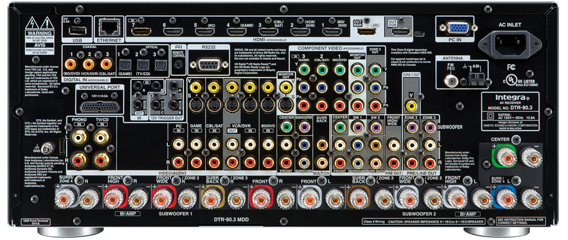With consumer electronics manufacturers stuffing more and more functionality into today’s Audio/Video Receiver (AVR), it’s sometimes hard to sort out the must-have features from the nice-to-haves. Although most home theater receivers will get the job done, there are a few features to look for and questions to ask yourself before heading to the store.
Receivers 101
First, you need to consider the core functions of an AVR. For starters, an AVR is an audio/video switching station which allows you to connect your source devices (Blu-ray player, DVR, game console, turntable, etc.) and easily select the one you want to use. The AVR is responsible for any audio decoding that’s needed, and it can also apply audio (and sometimes video).The receiver also needs to be able to amplify the audio signals and send them to your speakers.
5.1, 6.1. 7.2 or more audio channels?
When choosing a receiver, the first thing to consider is how many channels (speakers) of amplification are needed. Although many small to mid-size rooms get by just fine with 5.1, many modern film and concert soundtracks feature 7.1 sound – seven discreet channels of surround sound plus your bass/LFE channel (that’s the .1). Budget receivers typically offer five channels of amplification for 5.1, so you’ll have to step up if you’re looking for 7.1 (or 5.1 plus stereo in Zone 2).
3D Ready or Not
Many (but not all) of the latest receivers feature HDMI 1.4a-compliant inputs and therefore support 3D pass-thru from sources such as a Blu-ray 3D player. If wearing those snazzy 3D glasses is something you enjoy doing at home, make sure your new receiver is 3D-ready, which means it is compatible with the latest version of HDMI.
HDMI Inputs
Whether you’re hooking up a satellite or cable box, a DVD or Blu-ray Disc player, a game console, or a streaming media device such as AppleTV or the Roku box, HDMI is what you’re going to want to use for optimum picture and sound quality. With its one-cable simplicity, HDMI is the wiring standard for today’s digital landscape. Count up your source devices, add one or two for good measure, and make sure your new receiver has at least that many HDMI inputs.
Mobile Device Support
If you are an Apple user, look for a receiver with the “Made for iPod,” “Made for iPhone,” and “Made for iPad” logos. This will ensure smooth operation when controlling your iOS device. If you’re an Android user, look for a model that supports audio playback over USB (most iOS and many Android devices also support Bluetooth). Whether you’re using Apple or Android, check to see if the company offers a control app; sometimes these apps make for better remote controls than what you’re given in the box.
Apple AirPlay and iThings
If you’re an iFan and you’ve ditched your CD collection in favor of iTunes and iPod docks, you’ll definitely want to look for a receiver featuring integrated AirPlay support—the ability to wirelessly play your iPod/iPhone tunes through your audio gear. Most major receiver makers offer at least one or two AirPlay-compatible models.
Multi-Zone Options
If you hope to power a pair of speakers in the kitchen or by the pool, look for a receiver featuring multi-zone capabilities. Some receivers can send both audio and video to Zone 2 while others allow for audio only. Note that many models only allow analog inputs to serve as Zone 2 sources. Also, if the aforementioned AirPlay is important to you, look for a receiver that supports Zone 2 playback of AirPlay content.
Bonus Features
There are of course other features to consider when shopping for a receiver. To name but a few: integrated Sirius satellite radio; Audio Return Channel (ARC) support; DLNA certification for home network media sharing; Dolby Pro Logic IIz decoding for “height channel” support; and built-in Pandora and internet music streaming. Shoppers looking for these advanced options tend to live on the bleeding edge and will probably know more about these features than the average Best Buy salesman. For the rest of you, hopefully the above will serve as a helpful cheat sheet before you brave the crowds and find the receiver that’s right for you.


